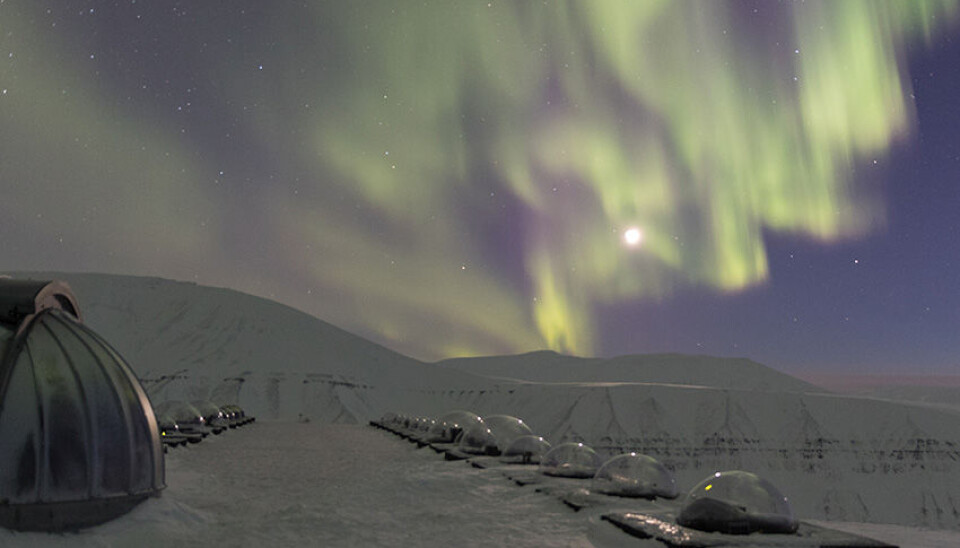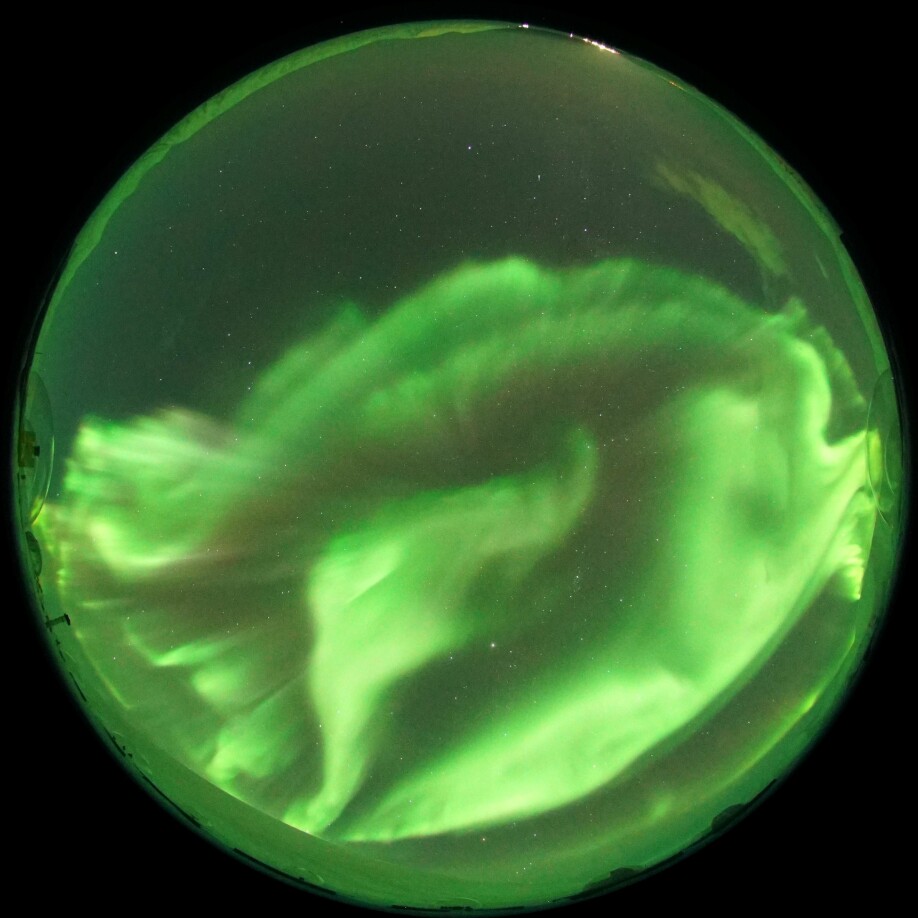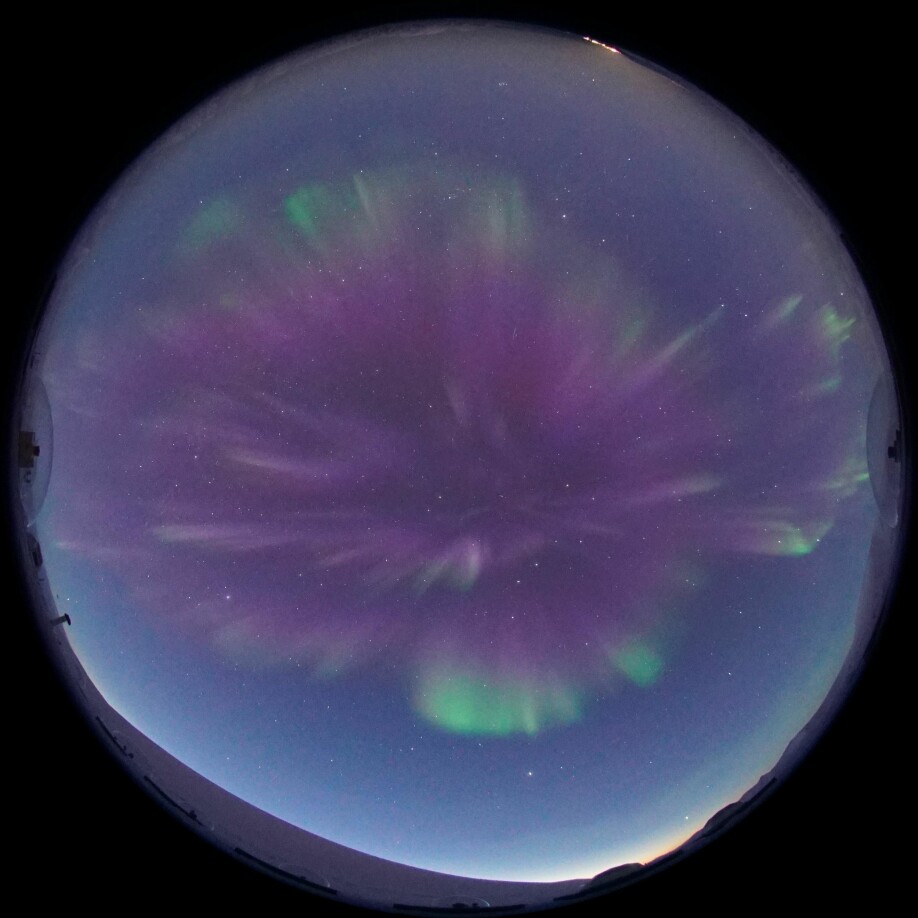Share your science:

Svalbard's special northern lights
SHARE YOUR SCIENCE: Svalbard's unique geographical position gives the opportunity to observe both the green night time aurora and the redder daytime aurora. But what is the difference?
The northern lights (Aurora borealis) have always fascinated people living in the Arctic. This flickering light over the winter sky was for a long time a mystery that one tried to understand. During the first International Polar Year in 1882/83, a Swedish research expedition overwintered on Svalbard to study, among other things, the aurora.
Based on measurements they found that both the green and the red aurora came from oxygen in the atmosphere, but under conditions different from those found near the earth's surface. They also suggested that the aurora is affected by the earth's magnetic field and flow high in the atmosphere. But how high? This was obviously difficult to find out, and they estimated the height to be between 5 and 1000 kilometers. When the Norwegian auroral researchers Carl Størmer and Ole Krogness in the early 20th century developed a camera that was sensitive enough to take pictures of the aurora, they found that the height varied between 90 to 300 km, with a maximum close to 110 km above the earth's surface.
The Sun and Earth's magnetic field connect
Størmer was the assistant to another well-known Norwegian auroral researcher - Kristian Birkeland. It is not known if Birkeland ever visited Svalbard, but he was the scientific leader of another auroral expedition on Spitsbergen in 1902/03. The expedition leader was Nils Christian Russeltvedt, and they set up their station on Akseløya in outer Van Mijenfjorden. Remains of this station still exist. Before this - in 1896 - Birkeland launched his theory that the aurora is created by particles coming from the Sun at a very high speed. These particles are captured by the earth's magnetic field and slowed down in the atmosphere, so that the atmospheric gases emit light.
Today we know that Birkeland’s theory is true. The Sun generates energy through the fusion of hydrogen into helium, and in this process, there is a little mass left over. It is this mass that is converted into energy in the form of sunlight and small particles that escape the Sun's strong gravitational and magnetic fields. The particles escaping form the solar wind, and it can take two to three days before the particles leave the Sun until they reach the Earth. The solar wind also carries parts of the Sun's magnetic field, which can connect with the earth's magnetic field. It is the reconnection between the two magnetic fields that gives the solar wind particles access to the earth's atmosphere.

Difference between dayside and nightside aurora
Earth's magnetic field has the same shape as a bar magnet - with a north and south pole. When the magnetic field from the solar wind and the magnetic field from the Earth connect, the solar wind particles are directed down towards the polar areas. We therefore get aurora borealis (and southern lights - aurora australis!) over the polar regions of the Earth when these particles collide with the upper atmosphere of the Earth. In a collision, energy is transferred from one body to another. This also happens when the solar wind particles collide with the atmospheric gases - mainly oxygen and nitrogen. The oxygen and nitrogen want to get rid of the extra energy they get through the collision and do so by emitting light.
The aurora can have many beautiful colors - both green and red aurora come from collisions with oxygen. Collisions with nitrogen can create both a deep red color, but also blue aurora. In Svalbard, we can observe the aurora both at night and during the day through the polar night. In the middle of winter, we have 24 hours of darkness and there is a difference between the aurora observed at night and what we observe during the day. The nightside aurora is dominated by green emissions from an altitude of around 120 km, while the dayside aurora is dominated by red emissions from an altitude of around 250 km. In addition to the visible difference between nightside and dayside aurora, there are also several other differences - such as the particle flux (higher for dayside) and the energy (lower for dayside) of the particles that collide with the atmospheric gases. But the main difference is something else we cannot see; the path the solar wind particles have taken to get down to the atmosphere.

Svalbard is just below the opening
The Earth's magnetic field extends several thousand kilometres into the near space. In addition to an atmosphere, the Earth therefore has a magnetosphere. The magnetosphere acts as a shield for particle radiation from the Sun, but as we have talked about, there is an opening in this shield over each of the polar regions. Svalbard's geographical location is such that during the day it is located just below the opening of the magnetosphere in the northern hemisphere. This means that during the day the solar wind particles have a direct access down to the Earth's atmosphere. It is these particles that create the dayside aurora. The solar wind particles that create the nightside aurora have a much more elaborate path before they end up in the atmosphere.
How the Earth's upper atmosphere and magnetosphere are affected by variations in the Sun is called space weather. Space weather can have a major impact on Earth technology, such as satellite navigation and radio communications. The auroras are a space weather phenomenon. Therefore, the aurora is used as an indicator of changes in space weather, and for studies of the interaction between the Sun and the Earth. This interaction is at its most direct over Svalbard, and most visible through the dayside aurora. This is what makes Svalbard so special and which is the reason for the many national and international research installations for auroral-related studies. Close to Longyearbyen are both the Kjell Henriksen Observatory, as well as the SuperDARN and EISCAT radars. In Ny-Ålesund, there are several auroral-related instruments and a rocket launching ramp for research sounding rockets. There is also auroral-related instrumentation in Barentsburg and at the Polish base in Hornsund.
Follow the northern lights
The auroral season 2020/21 is well under way. You can follow the aurora by visiting the website of Kjell Henriksen Observatory. There you will find data from multiple cameras and other instruments in real time. And Svalbard's special aurora - the dayside aurora? You can best see it around 10 o’clock in the morning.
Share your science or have an opinion in the Researchers' zone
The ScienceNorway Researchers' zone consists of opinions, blogs and popular science pieces written by researchers and scientists from or based in Norway.
Want to contribute? Send us an email!





























